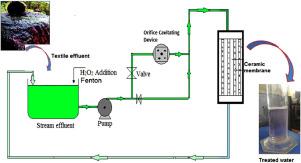Chemical Engineering and Processing: Process Intensification ( IF 3.8 ) Pub Date : 2021-07-11 , DOI: 10.1016/j.cep.2021.108540 Bhaskar Bethi 1 , Shirish H. Sonawane 2 , Bharat A. Bhanvase 3 , Shriram S. Sonawane 4

|
This work first time reports the intensification of real wastewater treatment by combination of hydrodynamic cavitation (HC), Fenton reagent, and membrane separation. In this work, a micro-porous ceramic membrane was used for the preparation of nano-porous catalytic membrane reactor. Initially, the aluminium boehmite sol has been synthesized and coated onto the tube side of the ceramic membrane by wet impregnation technique. A layer by layer technique was adopted for the wet impregnation of boehmite sol onto the ceramic membrane. After achieving a desired number of layers coating onto the ceramic membrane, a prepared catalyst sol was further used for coating. The dried boehmite powder was characterized using X-ray diffractometer and particle size distribution analysis. Mercury intrusion porosimetry (MIP) technique was used to identify the pore size distribution of modified ceramic membrane. The modified ceramic membrane was used in conjunction with HC for industrial dye wastewater treatment. The impact of process parameter such as cavitation unit (orifice) inlet pressure, intensifying chemical additive like Fenton reagent, and H2O2 dosage was investigated. HC along with intensifying chemical additives H2O2 and Fenton reagent improved the organic pollutants removal from textile industry wastewater
中文翻译:

空化结合芬顿和陶瓷纳滤膜处理纺织工业废水
这项工作首次报道了通过结合水动力空化 (HC)、芬顿试剂和膜分离来强化实际废水处理。在这项工作中,微孔陶瓷膜被用于制备纳米多孔催化膜反应器。最初,铝勃姆石溶胶已经合成并通过湿浸技术涂覆到陶瓷膜的管侧。采用逐层技术将勃姆石溶胶湿浸渍到陶瓷膜上。在陶瓷膜上达到所需层数后,进一步使用制备的催化剂溶胶进行涂覆。干燥的勃姆石粉末使用 X 射线衍射仪和粒度分布分析进行表征。使用压汞法(MIP)技术来确定改性陶瓷膜的孔径分布。改性陶瓷膜与HC结合用于工业染料废水处理。空化装置(孔板)入口压力、芬顿试剂等强化化学添加剂、H 等工艺参数的影响研究了 2 O 2剂量。HC 连同强化化学添加剂 H 2 O 2和芬顿试剂改善了纺织工业废水中有机污染物的去除











































 京公网安备 11010802027423号
京公网安备 11010802027423号